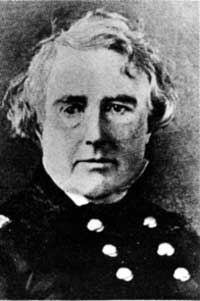|
FORT DAVIS National Historic Site |
 |
Founding of Fort Davis
 Bvt. Maj. Gen. Persifor F. Smith commanded the Department of Texas in 1854 and personally selected the site of Fort Davis. National Archives |
MILITARY AUTHORITIES AT department headquarters in San Antonio believed that the proposed fort in the Trans-Pecos should be located either in the vicinity of the Painted Comanche Camp or across the river from Presidio del Norte, to the south. The department commander, Bvt. Maj. Gen. Persifor F. Smith, set forth early in September 1854 to inspect the troublesome western portion of his department and to select a site for the new post. Its garrison, six companies of the 8th Infantry commanded by Lt. Col. Washington Seawell, was to follow General Smith, who planned first to inspect Fort Bliss, then to meet Seawell and his troops at the Painted Comanche Camp early in October.
Returning from Fort Bliss, the general gained some knowledge of the Apache problem. Near Eagle Springs a party of travelers reported that Indians had run off their stock the day before Smith detached part of his escort—41 men of the Regiment of Mounted Riflemen under Capt. John G. Walker and Lt. Eugene A. Carr—to follow the trail of the stolen cattle. In the Sierra Diablo the pursuers overtook their quarry and surprised a Mescalero village. In an action that lasted most of the day, Walker routed the Indians and inflicted casualties of 6 or 7 killed and 12 to 14 wounded. He lost one man killed, and his lieutenant and the guide were dangerously wounded. Lieutenant Carr later recovered and after the Civil War became a distinguished Indian fighter.
On October 5 General Smith and his escort bivouacked at the Painted Comanche Camp. Two days later Colonel Seawell and the vanguard of his command rolled up the Limpia and made camp. During September two long wagon trains had transported the regimental headquarters, band, and six companies of the 8th Infantry over the Lower Road. On October 11 the second train arrived. The general went to Presidio del Norte to consider locating the post there. He was back by the 23d, convinced of the superiority of the Painted Camp. It offered plenty of wood, water, and grass—requisites for a frontier military installation. Strategically located on the Lower Road, it commanded the Mescalero Apache country and lay within striking distance of the Great Comanche War Trail. The site had already been filed upon by John James, a San Antonio surveyor, and it was leased by the Army from him and his heirs, with one interruption, for the next 37 years.
Head Quarters, Department of Texas
Painted Camp on the "Limpia"
October 23d, 1854 Order No. 129Lieutenant Colonel Washington Seawell with his command of six companies of the 8th Infantry will occupy the Camp where he is at present in position, which will be called "Fort Davis," where he will proceed to make his command as comfortable as circumstances will admit of for the winter. He will immediately make requisitions for the necessary stores, provisions and forage for the half year commencing November 1st next, drawing as little as possible upon forage already, and about, to be delivered.
Preparations will be made for an additional quantity of provisions, supplies and forage for detachments which may shortly be expected for service in the field.
By order of Bvt. Maj. Gen'l Smith
A. GIBBS
Bvt. Capt. A.D.C. & A.A.A.G.
On October 23, 1854, General Smith issued orders establishing Fort Davis, which was named for Secretary of War Jefferson Davis. The general himself chose the spot where the post was to rise. It was in a canyon about a quarter of a mile south of the Painted Camp. On three sides palisaded rock walls rose abruptly from the canyon floor, terminating at the top in grassy hills. Considering the tactical situation, this was not the wisest choice, for an enemy could, and later did, approach very near without discovery. Seawell wished instead to establish the fort near a bubbling spring on the prairie opposite the mouth of the canyon, where it was in fact rebuilt after the Civil War. Whether he voiced this opinion to General Smith is not known, but throughout his service at Fort Davis he clung to the hope of one day building a fine new post of stone outside the canyon. Meanwhile, he contented himself with erecting temporary structures of pine slabs and canvas on the site inside the canyon designated by General Smith.

|
| History | Links to the Past | National Park Service | Search | Contact |
|
Last Modified: Fri, Oct 18 2002 10:00:00 pm PDT |


